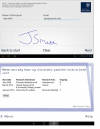Dynamic consent: a possible solution to improve patient confidence and trust in how electronic patient records are used in medical research
- PMID: 25586934
- PMCID: PMC4319083
- DOI: 10.2196/medinform.3525
Dynamic consent: a possible solution to improve patient confidence and trust in how electronic patient records are used in medical research
Abstract
With one million people treated every 36 hours, routinely collected UK National Health Service (NHS) health data has huge potential for medical research. Advances in data acquisition from electronic patient records (EPRs) means such data are increasingly digital and can be anonymised for research purposes. NHS England's care.data initiative recently sought to increase the amount and availability of such data. However, controversy and uncertainty following the care.data public awareness campaign led to a delay in rollout, indicating that the success of EPR data for medical research may be threatened by a loss of patient and public trust. The sharing of sensitive health care data can only be done through maintaining such trust in a constantly evolving ethicolegal and political landscape. We propose that a dynamic consent model, whereby patients can electronically control consent through time and receive information about the uses of their data, provides a transparent, flexible, and user-friendly means to maintain public trust. This could leverage the huge potential of the EPR for medical research and, ultimately, patient and societal benefit.
Keywords: NHS; care.data; confidentiality; data linkage; dynamic consent; electronic patient record (EPR); governance; medical research; privacy.
Conflict of interest statement
Conflicts of Interest: None declared.
Figures
References
-
- NHS Confederation. [2014-05-08]. Key statistics on the NHS http://www.nhsconfed.org/priorities/political-engagement/Pages/NHS-stati....
-
- Smeeth L, Hall AJ, Fombonne E, Rodrigues LC, Huang X, Smith PG. A case-control study of autism and mumps-measles-rubella vaccination using the general practice research database: Design and methodology. BMC Public Health. 2001;1:2. http://www.biomedcentral.com/1471-2458/1/2 - PMC - PubMed
-
- Wallace P, Delaney B, Sullivan F. Unlocking the research potential of the GP electronic care record. Br J Gen Pract. 2013 Jun;63(611):284–285. doi: 10.3399/bjgp13X668023. http://bjgp.org/cgi/pmidlookup?view=long&pmid=23735377 - DOI - PMC - PubMed
-
- Health and social care data access request service. [2014-09-04]. http://www.hscic.gov.uk/dars.
-
- ISD Scotland. [2014-09-04]. Information services division http://www.isdscotland.org/
Grants and funding
LinkOut - more resources
Full Text Sources
Other Literature Sources
Miscellaneous


